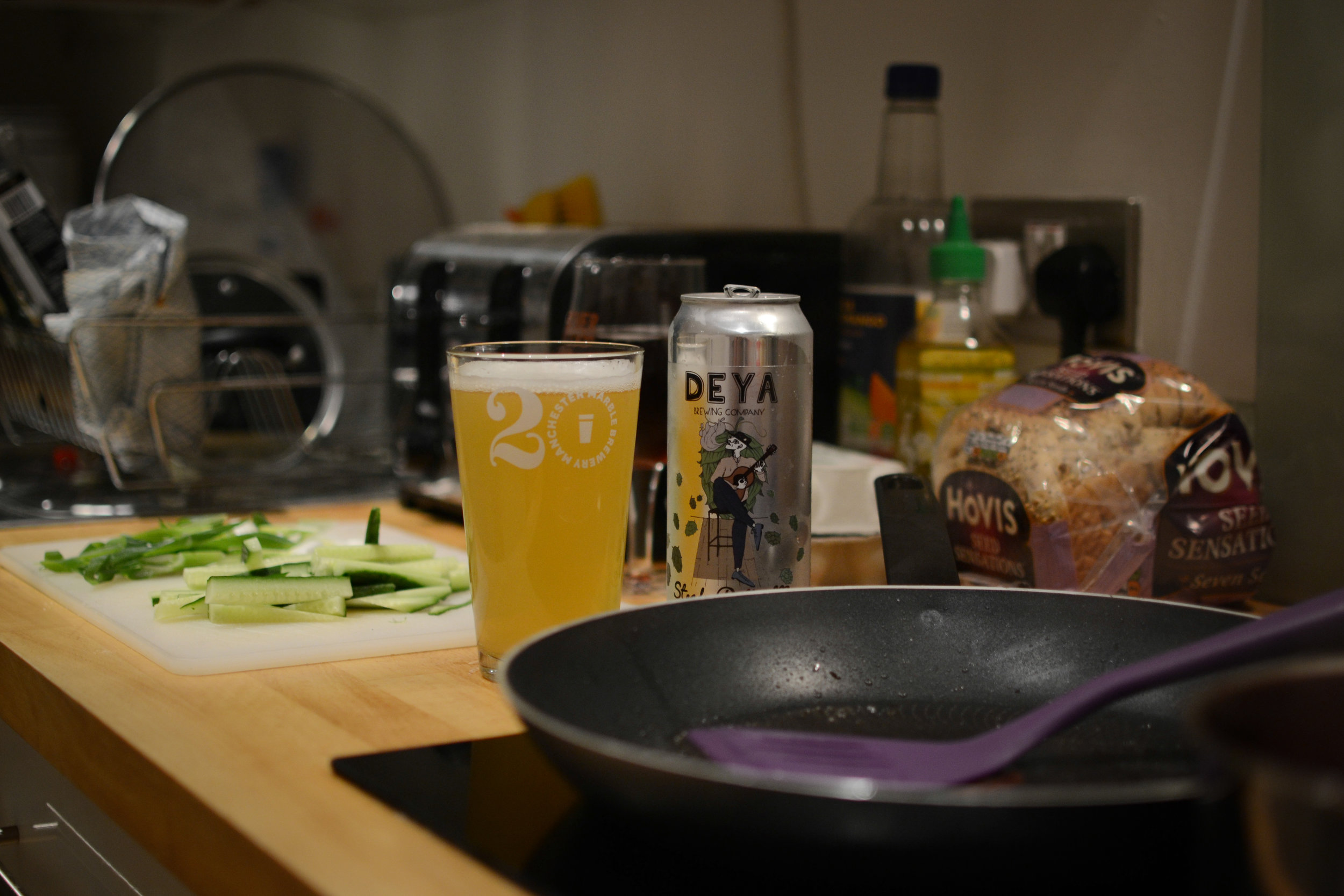I can count the number of times I’ve bought six bottles or cans of the same beer at once on both hands. Most of those instances were in preparation for music festivals—a six-pack or two of something from the supermarket in order to avoid drinking warm cider or dubiously mixed gin and tonics. Not only is the act of buying a sixer somewhat alien to British drinking culture, but I’m also one of those beer drinkers who’s usually on the lookout for something new.
Still, the prospect of picking up a six-pack on assignment is a little exciting—and although buying six of the same beer might seem like a challenge to someone with a penchant for variety like myself, I’m ready to get stuck in.
I have a nostalgic and very familiar relationship with DEYA Brewing Company. I remember first hearing about them when I was working at The Wild Beer Co.’s bar in my hometown of Cheltenham, in southwest England, where DEYA is also based. My friend Taylor had invited me to go and visit the brewery, and while I didn’t make the journey across town that day, DEYA’s first beer ended up on our tap list soon after: Steady Rolling Man, a 5.2% Pale Ale.
Today, DEYA is regarded as one of the top producers of New England-style beer in the U.K. Alongside the likes of Burnt Mill, Northern Monk, and Verdant, they’re riding the hazy train, which currently shows no signs of slowing. Since resuming canning last year following a hiatus due to mobile canning issues, DEYA’s releases sell out fast, and drinkers across the country jump at the chance to try their beers whenever they appear on draft. In my mind, their Pales and IPAs are up there with the best of the U.S. juice I’ve tried, which is testament to the high-quality, modern beer being produced within the U.K. right now.
I remember Steady Rolling Man back when it was almost clear, which may be strange to hear, given the general opacity of DEYA’s beers (Steady—as it’s affectionately known—now included). In the two or so years that I’ve been drinking it, Steady has become an old faithful to which I can always turn. It’s also a benchmark against which to measure other hazy beers, and is, put simply, a consistently brilliant Pale.
It only made sense, then, to pick up six tall, shining cans of Steady for this piece. After pulling up outside DEYA’s lot on a quiet industrial estate, I wave to a couple of old schoolmates who are sitting outside before making my way into the cool of the taproom. After a brief chat with my friend Connor (now an assistant in the brewhouse) while leaning over the beautiful wooden slab of the bar top, I collect my cans, which were packaged just three days earlier. Somehow I manage to resist the temptation of a swift half of whatever delicious new release has just been tapped, and make my way home.
I’ve just spent 11 hours in my studio back in Kingston, southwest London, in sweltering heat, with a fan blowing nothing but warm air. As I cycle home, all I can think of are the six tallboys in the fridge, protected from the oppressive heatwave we’re in the midst of. I envision the snap and the hiss of the can, the first sip, the anticipation.
Sitting out on the roof terrace of my new apartment, while reading a bizarre collection of Donald Trump’s tweets arranged as poetry (it’s hilarious), I crack open the first can. I can smell the aroma of stone fruit and juicy hops billowing forth, which instantly makes my mouth water. I pour the beer into a glass, relieve it of its charge, and refill—it’s gone in minutes.
The six-pack slips to the back of my mind for a week or so—given the backlog of beers in my fridge, that isn’t surprising. I finally remember it when, overdue a catch-up, I invite my friend Stef over for leftover noodles and a couple beers. She asks if I need anything picking up, but I say no—I’ve got a few Steadies, after all. Stef and I both grew up in Cheltenham and both worked previously for Wild Beer Co., which means she’s also’s familiar with DEYA. In fact, her family’s two golden retrievers, Neville and Luna, have become regulars at the taproom.
Although Stef holds onto her can a little longer than I do, once again neither lasts long. We chew the fat, talk about work and house-hunting, and from time to time make eye contact mid-swig, frown, and nod in a universal, salutary, damn-this-is-delicious gesture. Whether it’s general excitement, thirst after a day in the office, or the fact that the beer is tasting so great, the cans are soon empty. We crack open a few more beers, and wade our way through Amazing Interiors on Netflix. Some people have fascinating tastes, huh.
ArcTanGent is the best musical festival in the world. There, I said it. Probably, definitely the only festival dedicated to post- and math-rock, ATG draws people from all over to an almost-always-rainy field in Somerset, in England’s southwest. With only 3,000-odd people in attendance, it’s pretty tiny in comparison to most music festivals: you could fit the entirety of ATG into one campsite. As such, you inevitably end up hanging out with, and subsequently drinking with, old friends (and random new ones). Especially, if this year is anything to go by, wonderful Irish ones.
In the past, I would have taken as much cheap beer as I could carry to a festival like this. This time I probably go a little overboard, but, if kept chilled, Hazy IPAs and boozy Imperial Stouts are actually the ideal drinks to go with walloping heavy psych, post-hardcore, and gospel death metal. Steady makes the perfect interlude before Part Chimp’s sludgy, brain-rattling set. (You really should check them out, incidentally.)
A couple weeks later, and after a deluge of heavy rain, the thought of a sizable journey across South London, plus a hefty dose of laziness, puts my girlfriend Charlotte and me off the Deptford Craft Beer Feast. Instead, we decide to stay in, roast some pork, and binge-watch period dramas. Having realized too late that we realistically don’t have time to cook said roast, however, we opt for something a little simpler. While making a Rodenbach reduction for the duck searing in the pan, I crack open my penultimate can of Steady. I expected the aroma to have faded a little after six weeks, but remarkably, the fragrant blast of stone fruit springs out of the can once again, overpowering the smells of frying and bubbling Flanders Red.
This hopped-up, easy-drinking Pale makes a great cooking beer, I soon discover. It’s perfect for the moments prior to serving up, when you’ve got four or five dishes all needing your attention and require a swig of something refreshing. It makes a great starter, too—especially when the main is The Bruery’s Tart of Darkness.
Given hazy beer’s propensity for hop fade, I’d rather not sit on the final can for much longer—and given that my calendar’s looking a little full for the next couple of weeks, any opportunity is a good one. After shopping for various homewares and other such flotsam and jetsam, my girlfriend and I take a stroll along the River Thames, and share the last can.
I’m still trying to get Charlotte into beers that aren’t sour (or Barleywines), but this might not be the one to do so. While the juicy fruitiness of the beer is to her liking, she hasn’t quite come around to the bitterness of Pales and IPAs. That means I get to enjoy the majority of it as we stroll down the riverside path, watching floating gin palaces cruise past and dogs bound along. We end up at a pub with a pretty average selection, but an insane number of beautiful pooches, and at least I’ve already had a can of my favorite beer. I guess it could be worse.


















